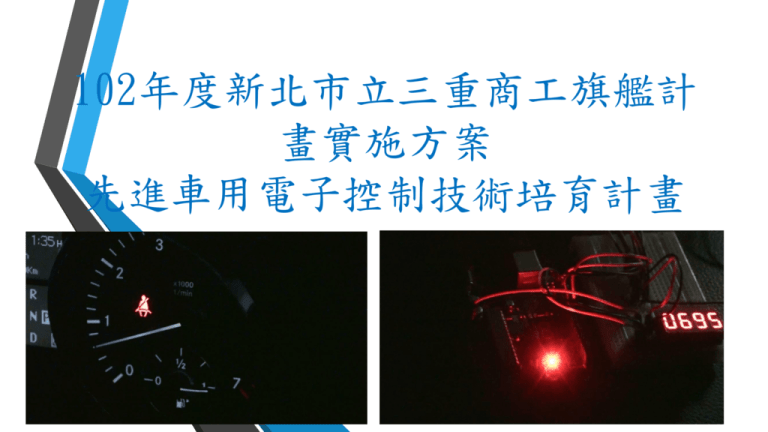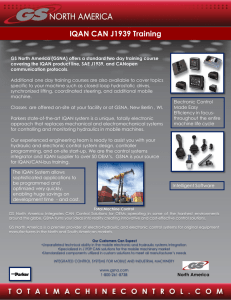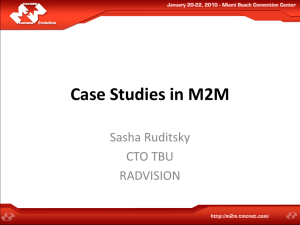ISO9141-2 on OBDII
advertisement

102年度新北市立三重商工旗艦計 畫實施方案 先進車用電子控制技術培育計畫 CANbus結合車控電腦技術研習 • • • 主辦單位:新北市立三重商工實習處、汽車科 協辦單位:新北市立三重商工教務處、聖約翰科技大學。 Special thanks to: 三重商工 汽車科 謝嘉聰主任 聖約翰科技大學林總務長 • • 主講人:聖約翰科技大學資訊工程系 鄭林合副教授 Outline • • Products • • On-Board Diagnostic • – OBD, OBD-I, OBD-II, OBD-III • – EOBD • • Support Protocol • – CAN, VPW, PWM, ISO, KWP • After 2008, CAN only • • Protocol • • Hardware • • Software • • Applications PC Type (USB) ScanGaugeII by Linear-Logic Ref :http://www.scantool.net/products/product_info.php?cPath=8&products_id=32 PC Type (USB) Stand-alone Type Ref :http://www.scantool.net/products/product_info.php?cPath=8&products_id=32 PDA Type Ref :http://www.pocketlogger.com/index.php?pid=plobdii_ss CAN ODBII D91汽車診斷儀器 BENZ BMW VW AUDI (AUTOLAND ) History of ODB EOBD • EOBD is a version of OBD-II required in Europe since Model Year 2004 for diesel vehicles and since 2001 for gasoline vehicles OBD II Support Protocol ISO 11898-x (road vehicles) Pin definitions of OBDII Connector Pin 2 - J1850 Bus+ Pin 4 - Chassis Ground Pin 5 - Signal Ground Pin 6 - CAN High (J-2284) Pin 7 - ISO 9141-2 K Line Pin 10 - J1850 Bus Pin 14 - CAN Low (J-2284) Pin 15 - ISO 9141-2 L Line Pin 16 - Battery Power Software Open Source Project • ELM 323 / 327 Software Written by Lancastrian IT • Software can download by : http://www.lancastrianit. co.uk/component/option,com_jdownloads/Itemid,5/ Ref: http://www.lancastrian-it.co.uk/BMW/elm-323-327-software.html ELM327 Universal Scantool OBD2 Free software Digimoto Lite EasyObd II 2005 Version 1.0 by EasyObdII.com - Steve Duddridge GM Mode 22 Scan Tool by Terry OBD Gauge for PalmOS and Pocket PC by Dana Peters • OBD Logger by Jonathan Senkerik OBD-II ScanMaster by Wladimir Gurskij obd2crazy.com OBD2 Scantool by Ivan Andrewjeski OBDII for ELM322 by David Huffman pyOBD by Donour Sizemore for MacOSX and Linux RDDTC for the PocketPC byPete Calinski Real Scan by Brent Harris ScanTest for Pocket PC by Ivan Ganev aka a-ser Servertec ScanTool Communications Gateway (Java) wOBD by WDT • Ref: http://www.lancastrian-it.co.uk/BMW/elm-323-327-software.html Non-free software Digimoto ElmOScan OBD2Spy PCMSCAN ProScan SoftDavid (in Spanish) VitalScan Ref: http://www.lancastrian-it.co.uk/BMW/elm-323-327-software.html OBD-II ScanMaster Hardware OBD-II Diagnostic connector 1. - 2. Bus positive Line of SAE-J1850 3. - Ford DCL(+) Argentina, Brasil (pre OBD-II) 1997-2000 4. Chassis ground 5. Signal ground 6. CAN high (ISO 15765-4 and SAE-J2234) 7. K line of ISO 9141-2 and ISO 14230-4 8. 9. 10. Bus negative Line of SAE-J1850 11. - Ford DCL(-) Argentina, Brasil (pre OBD-II) 1997-2000 12. 13. 14. CAN low (ISO 15765-4 and SAE-J2234) 15. L line of ISO 9141-2 and ISO 14230-4 16. Battery voltage SAE J1850 PWM • SAE J1850 PWM (pulse-width modulation - 41.6 kbaud, standard of the Ford Motor Company) • • • • • pin 2: Bus+ pin 10: Bus– High voltage is +5 V Message length is restricted to 12 bytes, including CRC Employs a multi-master arbitration scheme called 'Carrier Sense Multiple Access with Non-Destructive Arbitration' (CSMA/NDA) SAE J1850 VPW • SAE J1850 VPW (variable pulse width - 10.4/41.6 kbaud, standard of General Motors) • pin 2: Bus+ • • • • • Bus idles low High voltage is +7 V Decision point is +3.5 V Message length is restricted to 12 bytes, including CRC Employs CSMA/NDA ISO 9141-2 • ISO 9141-2. This protocol has a data rate of 10.4 kbaud, and is similar to RS-232. ISO 9141-2 is primarily used in Chrysler, European, and Asian vehicles. • • • • • • pin 7: K-line pin 15: L-line (optional) UART signaling (though not RS-232 voltage levels) K-line idles high High voltage is Vbatt Message length is restricted to 12 bytes, including CRC ISO9141-2 on OBDII • The ISO9141 standard – It specifies the requirements for setting up the interchange of digital information between an on board ECU and a suitable diagnostic tester to facilitate inspection, test, diagnosis and adjustment of vehicle’s ECUs ISO9141-2 on OBDII – The ECU must have one (K) or two ( K and L) communication connections – Connecting lines K or L from one or more ECUs together results in a bus system – Line K is defined as the line that provides information in a serial digital form from the ECU to the diagnostic tester • Line K may also be bi-directional, in which case it may carry commands or data form the diagnostic tester to the ECU ISO9141-2 on OBDII • Line K may also be used to initialize the serial communication • The standard K-line is ISO9141 compatible for baud rates up to 250kbps – Line L is a unidirectional line from the diagnostic tester to the ECU • It may be used to initialize the serial communication and/or to carry commands and/or data ISO9141-2 on OBDII ISO9141-2 on OBDII • ISO 9141-2 describes a subset of ISO9141 – It specifies the requirements for setting-up the interchange of digital information between onboard emission-related ECUs or road vehicles and the SAE OBDII scan tool – It is limited to vehicles with nominal 12 V supply voltage ISO 14230 KWP2000 • ISO 14230 KWP2000 (Keyword Protocol 2000) • pin 7: K-line • pin 15: L-line (optional) • • • Physical layer identical to ISO 9141-2 Data rate 1.2 to 10.4 kbaud Message may contain up to 255 bytes in the data field ISO 15765 CAN • ISO 15765 CAN (250 kbit/s or 500 kbit/s). The CAN protocol is a popular standard outside of the US automotive industry and is making significant in-roads into the OBD-II market share. By 2008, all vehicles sold in the US will be required to implement CAN, thus eliminating the ambiguity of the existing five signaling protocols. • • pin 6: CAN High pin 14: CAN Low Ground pins • pins 4 (battery ground) and 16 (battery positive) are present in all configurations. • ISO 9141 and ISO 14230 use the same pinout, thus the connector shape does not distinguish between the two. Protocol Nine modes of operation in ODB-II 1. Show current data 2. Show freeze frame data 3. Show stored Diagnostic Trouble Codes 4. Clear Diagnostic Trouble Codes and stored values 5. Test results, oxygen sensor monitoring 6. Test results, other component/system monitoring 7. Show pending Diagnostic Trouble Codes 8. Control operation of on-board component/system 9. Request vehicle information ISO9141-2 on OBDII – Data rates • • Wake-up (initialization) : 5 bps Normal operation: 10.4kbps ISO9141-2 on OBDII ISO9141-2 on OBDII ISO9141-2 on OBDII – Each PID was translated into meaningful parameter the predefined formula e.g., Vehicle Speed PID = 0x0D, 1 bytes is returned Units : km/h ISO9141-2 on OBDII ODB-II Message ISO9141-2 on OBDII J1939 on OBDII • The particular characteristics of J1939 – 29-bit identifier (extended-identifier message) – Peer-to-peer and broadcast communication – Transport protocols for up to 1785 data bytes (255 packets) – Network management – Definition of parameter groups J1939 on OBDII J1939 on OBDII J1939 on OBDII • J1939 main documents – SAE J1939 - Recommended Practice for a Serial Control & Communications – SAE J1939/11 - Physical Layer – SAE J1939/21 - Data Link Layer – SAE J1939/31 - Network Layer – SAE J1939/71 - Vehicle Application Layer – SAE J1939/73 - Application Layer Diagnostics – OBD • – SAE J1939/81 - Network management Protocol J1939 on OBDII J1939 on OBDII J1939 on OBDII ODB Message J1939 on OBDII • The PGN (Parameter Group Number) definitions – Parameter groups combine similar or associated signals • In the specification SAE J1939-71 the parameter groups are defined with the signals they contain – In addition, some manufacturer-specific parameter groups can be used J1939 on OBDII – Parameter groups with up to 8 data bytes are transmitted in a CAN message • With more that 8 bytes, a transport protocol is used – Each parameter group is addressed uniquely via a number (PGN) • For this number, a 16-bit value is used that is composed of the PDU format and PDU specific J1939 on OBDII – There are two types of parameter group numbers: • Global PGNs for parameter groups that are sent to all (broadcast) – Here all 16 bits of the PGN are used ≥ 0xF0 • Specific PGNs for the parameter groups that are sent to particular devices (peer-to-peer) – With these PGNs, only the higher-value 8-bit (PDU format) are valid and the value must be smaller than 240 ( < 0xF0) – The lower value byte (PDU specific) is always 0 J1939 on OBDII J1939 on OBDII J1939 on OBDII J1939 on OBDII • Transport protocols (for Specific PGNs ) – Parameter groups that contain more than 8 data bytes are transmitted with a transport protocol – There are two special parameter groups available • • TP.CM for connection management TP.DT for the transmission of the data J1939 on OBDII • There are two different protocols – Peer-to-peer – Broadcast transmission J1939 on OBDII – Broadcast transmission • For broadcast transmission, the BAM (Broadcast Announce Message) protocol (TP.CM_BAM) is used • Here, after a BAM-PGN (0xEC00) the transmitter sends all data PGs at a minimum interval of 50ms J1939 on OBDII J1939 on OBDII – Peer-to-peer transmission • With the peer-to-peer transmission, the transmitter initiates the connection with a “request to send” (TP.RTS) message • The receiver then controls the transport protocol with “clear to send” (TP.CTS) and “end of message acknowledge” (TP.EoMA) J1939 on OBDII J1939 on OBDII • The DTC (Diagnostic Trouble Code) definitions (SAE J1939-73) – A DTC is made up of 4 elements • • • • Suspect Parameter Number (SPN) 19 bits Failure Mode Identifier (FMI) 5 bits Occurrence Count (OC) 7 bits SPN Conversion Method (CM) 1 bit J1939 on OBDII J1939 on OBDII J1939 on OBDII J1939 on OBDII J1939 on OBDII CAN ODB Message PID query (Vehicle’s CAN Bus) PID response (Vehicle’s CAN Bus) Open Source • OBD II software ELM 327 USB is an open source project • ELM320 : SAE J1850 PWM • ELM322 : SAE J1850 VPW • ELM323 : ISO9141 • ELM327=ELM320+ELM322+ELM323 • interface + CAN BUS ELM 320 ODB (PWM) to RS-232 Interpreter ELM 320 PINOUT ELM320 to RS-232 Circuit ELM 322 ODB (VPW) to RS-232 Interpreter ELM 322 PINOUT ELM322 to RS-232 Circuit ELM 323 ODB (ISO) to RS-232 Interpreter ELM 323 PINOUT ELM323 to RS-232 Circuit A Simple ODB Monitor ELM 327 ODB to RS-232 Interpreter ELM 327 package ELM 327 General AT Command ELM 327 ODB Command ELM 327 ISO Command ELM 327 J1850 Command ELM 327 J1939 CAN Command Reference Design J1850 VPW to USB interpreter ELM 327 RS232 Interpreter Tester Mode of Operation • Mode $01 is used to identify what Powertrain information is available to the scan tool. • • Mode $02 displays Freeze Frame data. Mode $03 lists the total number of powertrain or emission related DTC stored. It also displays exact numeric, 5 digit codes identifying the faults. • • Mode $04 is used to clear DTCs and Freeze Frame. Mode $05 displays the oxygen sensor monitor screen and the test results gathered about the oxygen sensor. Ten numbers available for diagnostics • • • • • • • • • • $01 Rich-to-Lean O2 sensor threshold voltage $02 Lean-to-Rich O2 sensor threshold voltage $03 Low sensor voltage threshold for switch time measurement $04 High sensor voltage threshold for switch time measurement $05 Rich-to-Lean switch time in ms $06 Lean-to Rich switch time in ms $07 Minimum voltage for test $08 Maximum voltage for test $09 Time between voltage transitions in ms Mode $06 is a Request for On-Board Monitoring Test Results for Non-Continuously Monitored System. There are typically a minimum value, a maximum value, and a current value for each noncontinuous monitor. • Mode $07 is a Request for continuously Monitored Systems. This is used by service technicians after a vehicle repair, and after clearing diagnostic information to see test results after a single driving cycle to determine if the repair has fixed the problem. • There are only three continuous monitors to be identified: fuel, misfire, and the comprehensive component. • Mode $08 could enable the off-board test device to control the operation of an on-board system, test, or component. • • Mode $09 is used to deliver IUMPR. (In Use Monitor Performance Ratio) Mode $0A is required to store Permanent DTCs as per CARB. ELM Series tester Talking to Vehicle • Reading Battery Voltage >AT RV 12.5 Talking to Vehicle Talking to Vehicle PID, Mode PID, Mode Quick Guide for Reading Trouble Codes SAE standards documents on OBD-II • • J1962 - Defines the physical connector used for the OBD-II interface. J1850 - Defines a serial data protocol. There are 2 variants- 10.4 kbit/s (single wire, VPW) and 41.6 kbit/s (2 wire, PWM). Mainly used by US manufacturers, also known as PCI (Chrysler, 10.4K), Class 2 (GM, • • • • • • • • • 10.4K), and SCP (Ford, 41.6K) J1978 - Defines minimal operating standards for OBD-II scan tools J1979 - Defines standards for diagnostic test modes J2012 - Defines standards trouble codes and definitions. J2178-1 - Defines standards for network message header formats and physical address assignments J2178-2 - Gives data parameter definitions J2178-3 - Defines standards for network message frame IDs for single byte headers J2178-4 - Defines standards for network messages with three byte headers* J2284-3 - Defines 500K CAN Physical and Data Link Layer • • • • • ISO standards ISO 9141: Road vehicles— Diagnostic systems. International Organization for Standardization, 1989. Part 1: Requirements for interchange of digital information Part 2: CARB requirements for interchange of digital information Part 3: Verification of the communication between vehicle and OBD II scan tool ISO 11898: Road vehicles — Controller area network (CAN). International Organization for Standardization, 2003. • • • • • Part 1: Data link layer and physical signalling Part 2: High-speed medium access unit Part 3: Low-speed, fault-tolerant, medium-dependent interface Part 4: Time-triggered communication ISO 14230: Road vehicles — Diagnostic systems — Keyword Protocol 2000, International Organization for Standardization, 1999. • • • • • Part 1: Physical layer Part 2: Data link layer Part 3: Application layer Part 4: Requirements for emission-related systems ISO 15765: Road vehicles — Diagnostics on Controller Area Networks (CAN). International Organization for Standardization, 2004. • • • • Part 1: General information Part 2: Network layer services Part 3: Implementation of unified diagnostic services (UDS on CAN) Part 4: Requirements for emissions-related systems Anatomy of the DTC First Character ⎯ System Second Digit –Code Type Third Digit ⎯ Sub-System Fourth and Fifth ⎯ Digits OBD II Standard Fault Codes • • • • P01XX Fuel and Air Metering P0100 Mass or Volume Air flow Circuit Malfunction P0101 Mass or Volume Air flow Circuit Range/Performance Problem P0102 Mass or Volume Air Flow Circuit low Input P0103 Mass or Volume Air flow Circuit High Input P0104 Mass or Volume Air flow Circuit • • • Intermittent P0105 Manifold Absolute Pressure/Barometric Pressure Circuit Malfunction P0106 Manifold Absolute Pressure/Barometric Pressure Circuit Range/Performance Problem P0107 Manifold Absolute Pressure/Barometric Pressure Circuit Low Input P0108 Manifold Absolute Pressure/Barometric Pressure Circuit High Input • • • • • P0109 Manifold Absolute Pressure/Barometric Pressure Circuit Intermittent …… P08XX Transmission P080l Reverse Inhibit Control Circuit Malfunction P0803 1-4 Upshift (Skip Shift) Solenoid Control Circuit Malfunction P0804 1-4 Upshift (Skip Shift) Lamp Control Circuit Malfunction ODB II Trouble Code • http://www.obdii.com/codes.asp



